P3 Application of different theories & models of approach of leadership
VerifiedAdded on 2021/01/02
|16
|4029
|51
AI Summary
Contribute Materials
Your contribution can guide someone’s learning journey. Share your
documents today.
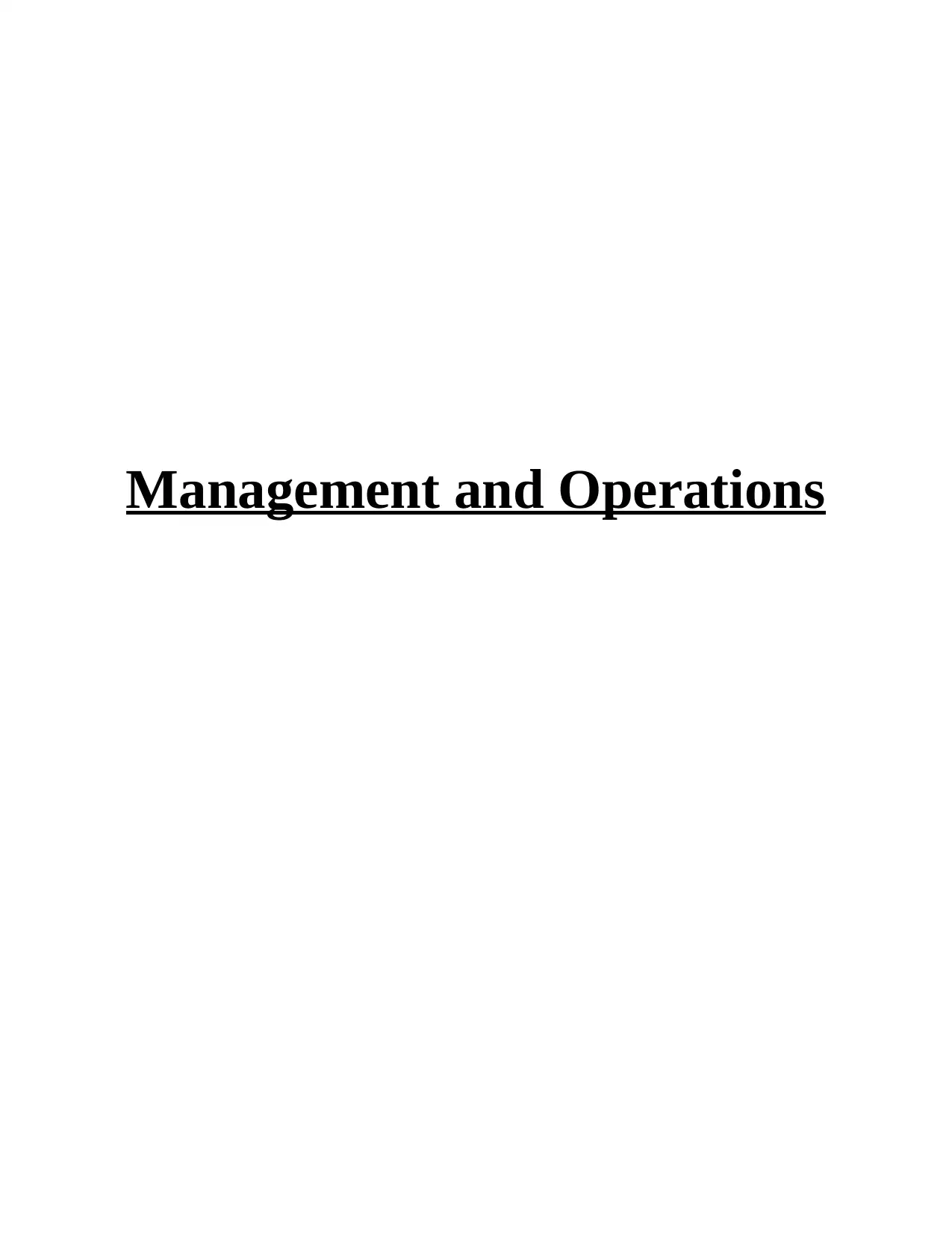
Management and Operations
Secure Best Marks with AI Grader
Need help grading? Try our AI Grader for instant feedback on your assignments.
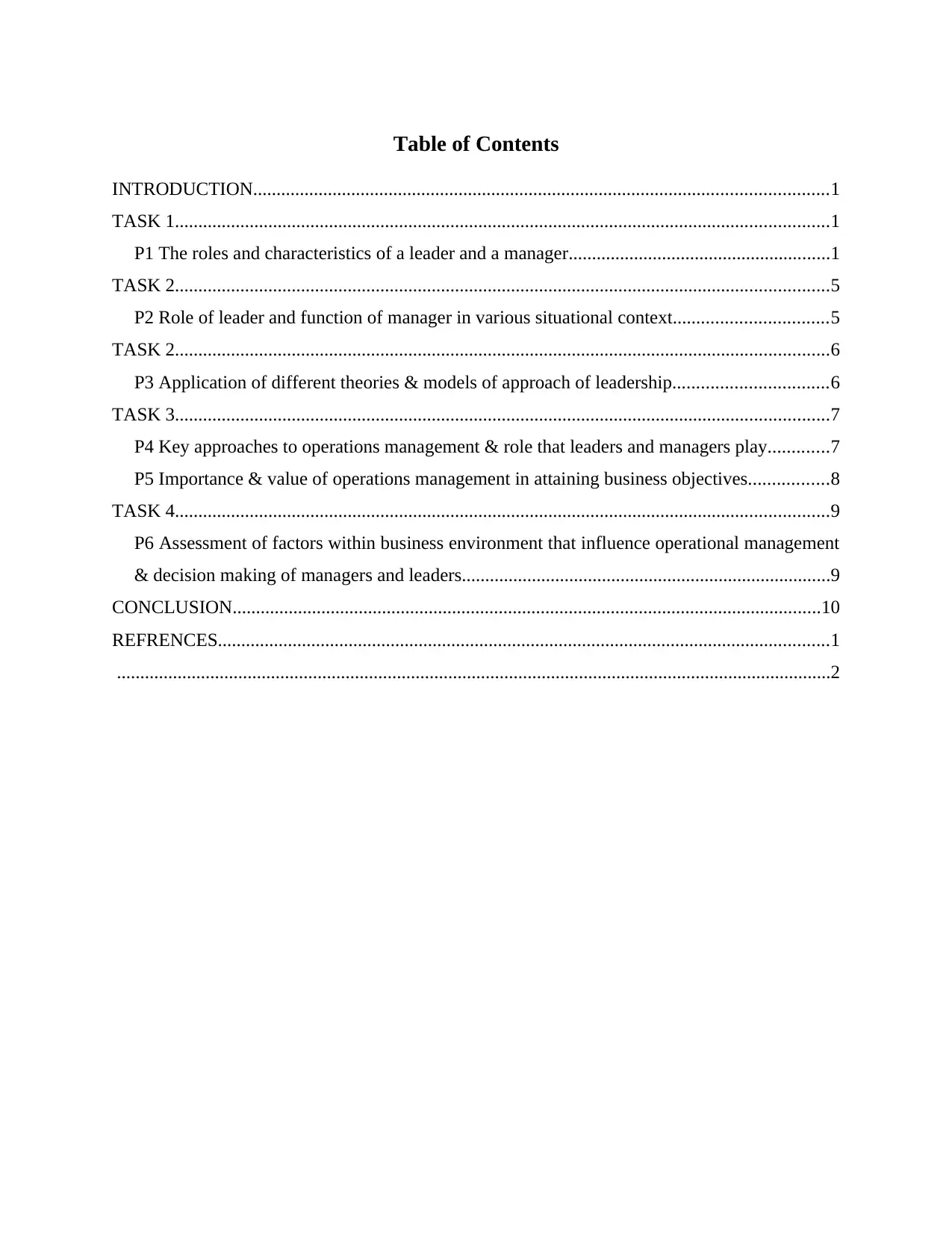
Table of Contents
INTRODUCTION...........................................................................................................................1
TASK 1............................................................................................................................................1
P1 The roles and characteristics of a leader and a manager........................................................1
TASK 2............................................................................................................................................5
P2 Role of leader and function of manager in various situational context.................................5
TASK 2............................................................................................................................................6
P3 Application of different theories & models of approach of leadership.................................6
TASK 3............................................................................................................................................7
P4 Key approaches to operations management & role that leaders and managers play.............7
P5 Importance & value of operations management in attaining business objectives.................8
TASK 4............................................................................................................................................9
P6 Assessment of factors within business environment that influence operational management
& decision making of managers and leaders...............................................................................9
CONCLUSION..............................................................................................................................10
REFRENCES...................................................................................................................................1
.........................................................................................................................................................2
INTRODUCTION...........................................................................................................................1
TASK 1............................................................................................................................................1
P1 The roles and characteristics of a leader and a manager........................................................1
TASK 2............................................................................................................................................5
P2 Role of leader and function of manager in various situational context.................................5
TASK 2............................................................................................................................................6
P3 Application of different theories & models of approach of leadership.................................6
TASK 3............................................................................................................................................7
P4 Key approaches to operations management & role that leaders and managers play.............7
P5 Importance & value of operations management in attaining business objectives.................8
TASK 4............................................................................................................................................9
P6 Assessment of factors within business environment that influence operational management
& decision making of managers and leaders...............................................................................9
CONCLUSION..............................................................................................................................10
REFRENCES...................................................................................................................................1
.........................................................................................................................................................2

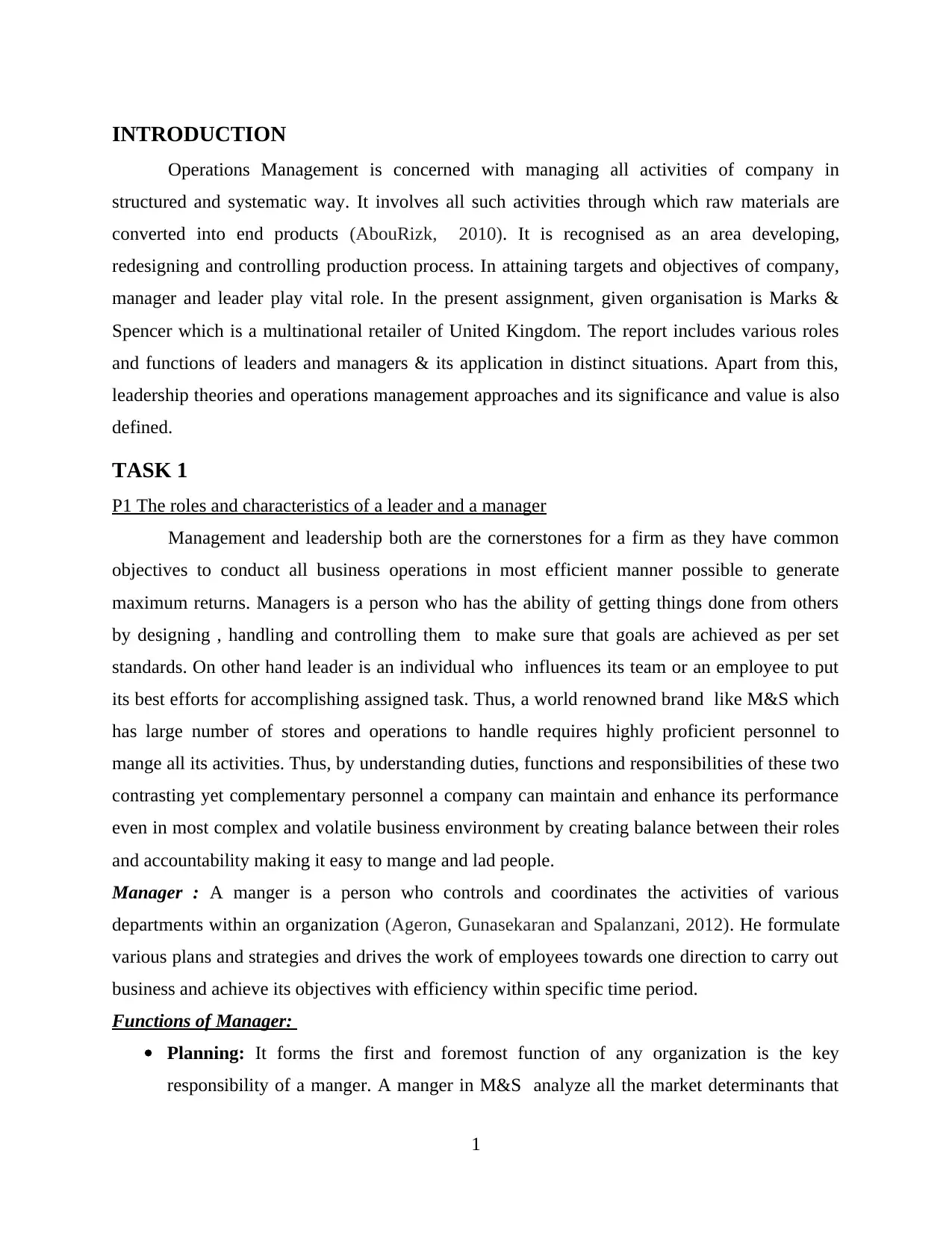
INTRODUCTION
Operations Management is concerned with managing all activities of company in
structured and systematic way. It involves all such activities through which raw materials are
converted into end products (AbouRizk, 2010). It is recognised as an area developing,
redesigning and controlling production process. In attaining targets and objectives of company,
manager and leader play vital role. In the present assignment, given organisation is Marks &
Spencer which is a multinational retailer of United Kingdom. The report includes various roles
and functions of leaders and managers & its application in distinct situations. Apart from this,
leadership theories and operations management approaches and its significance and value is also
defined.
TASK 1
P1 The roles and characteristics of a leader and a manager
Management and leadership both are the cornerstones for a firm as they have common
objectives to conduct all business operations in most efficient manner possible to generate
maximum returns. Managers is a person who has the ability of getting things done from others
by designing , handling and controlling them to make sure that goals are achieved as per set
standards. On other hand leader is an individual who influences its team or an employee to put
its best efforts for accomplishing assigned task. Thus, a world renowned brand like M&S which
has large number of stores and operations to handle requires highly proficient personnel to
mange all its activities. Thus, by understanding duties, functions and responsibilities of these two
contrasting yet complementary personnel a company can maintain and enhance its performance
even in most complex and volatile business environment by creating balance between their roles
and accountability making it easy to mange and lad people.
Manager : A manger is a person who controls and coordinates the activities of various
departments within an organization (Ageron, Gunasekaran and Spalanzani, 2012). He formulate
various plans and strategies and drives the work of employees towards one direction to carry out
business and achieve its objectives with efficiency within specific time period.
Functions of Manager:
Planning: It forms the first and foremost function of any organization is the key
responsibility of a manger. A manger in M&S analyze all the market determinants that
1
Operations Management is concerned with managing all activities of company in
structured and systematic way. It involves all such activities through which raw materials are
converted into end products (AbouRizk, 2010). It is recognised as an area developing,
redesigning and controlling production process. In attaining targets and objectives of company,
manager and leader play vital role. In the present assignment, given organisation is Marks &
Spencer which is a multinational retailer of United Kingdom. The report includes various roles
and functions of leaders and managers & its application in distinct situations. Apart from this,
leadership theories and operations management approaches and its significance and value is also
defined.
TASK 1
P1 The roles and characteristics of a leader and a manager
Management and leadership both are the cornerstones for a firm as they have common
objectives to conduct all business operations in most efficient manner possible to generate
maximum returns. Managers is a person who has the ability of getting things done from others
by designing , handling and controlling them to make sure that goals are achieved as per set
standards. On other hand leader is an individual who influences its team or an employee to put
its best efforts for accomplishing assigned task. Thus, a world renowned brand like M&S which
has large number of stores and operations to handle requires highly proficient personnel to
mange all its activities. Thus, by understanding duties, functions and responsibilities of these two
contrasting yet complementary personnel a company can maintain and enhance its performance
even in most complex and volatile business environment by creating balance between their roles
and accountability making it easy to mange and lad people.
Manager : A manger is a person who controls and coordinates the activities of various
departments within an organization (Ageron, Gunasekaran and Spalanzani, 2012). He formulate
various plans and strategies and drives the work of employees towards one direction to carry out
business and achieve its objectives with efficiency within specific time period.
Functions of Manager:
Planning: It forms the first and foremost function of any organization is the key
responsibility of a manger. A manger in M&S analyze all the market determinants that
1
Secure Best Marks with AI Grader
Need help grading? Try our AI Grader for instant feedback on your assignments.

affects its business comprising competitors, consumers taste and preferences, current
market trends etc and on behalf of this research he plans out various strategies and
activities that could help a firm to efficiently and effectively attain its targets (Ashby,
Leat and Hudson-Smith, 2011). In addition, the manger is also responsible for planning
out various team building activities to maintain cordial relations and develop coordination
among its workforce. In addition, they make numerous plans and from that they select
the best plans which can produce good results.
Organizing: Another function carried out by mangers in M&S are to organize all the
resources i.e. Finance, staff and material that are requisite for smooth functioning of
firm. The mangers also carries out the task of allocating these resources to each
departments by ascertaining the requirements of each divisions. Thus, mangers ensures
that there is no hindrance experiences in achievement of organizational goals by adopting
best course of actions that complements each divisions to successfully attain their
assigned tasks.
Staffing: As employees forms the backbone of any organization who serves as a source
of innovative ideas, skills and knowledge utilizing whose capabilities and efforts a firm
generates profits and high sales volume (Chowdary and George, 2011). Thus, to ensure
that company has proficient candidate at right job profile presented at right time
whenever he is requires M&S plays critical attention during its hiring process. A
candidate is evaluated on skills, qualification and capabilities by manger of M&S by
conducting various aptitude, IQ and other behavior related tests and also by matching his
profile with the job specification of a particular position to ensure efficiency and work
performance of each employee.
2
market trends etc and on behalf of this research he plans out various strategies and
activities that could help a firm to efficiently and effectively attain its targets (Ashby,
Leat and Hudson-Smith, 2011). In addition, the manger is also responsible for planning
out various team building activities to maintain cordial relations and develop coordination
among its workforce. In addition, they make numerous plans and from that they select
the best plans which can produce good results.
Organizing: Another function carried out by mangers in M&S are to organize all the
resources i.e. Finance, staff and material that are requisite for smooth functioning of
firm. The mangers also carries out the task of allocating these resources to each
departments by ascertaining the requirements of each divisions. Thus, mangers ensures
that there is no hindrance experiences in achievement of organizational goals by adopting
best course of actions that complements each divisions to successfully attain their
assigned tasks.
Staffing: As employees forms the backbone of any organization who serves as a source
of innovative ideas, skills and knowledge utilizing whose capabilities and efforts a firm
generates profits and high sales volume (Chowdary and George, 2011). Thus, to ensure
that company has proficient candidate at right job profile presented at right time
whenever he is requires M&S plays critical attention during its hiring process. A
candidate is evaluated on skills, qualification and capabilities by manger of M&S by
conducting various aptitude, IQ and other behavior related tests and also by matching his
profile with the job specification of a particular position to ensure efficiency and work
performance of each employee.
2
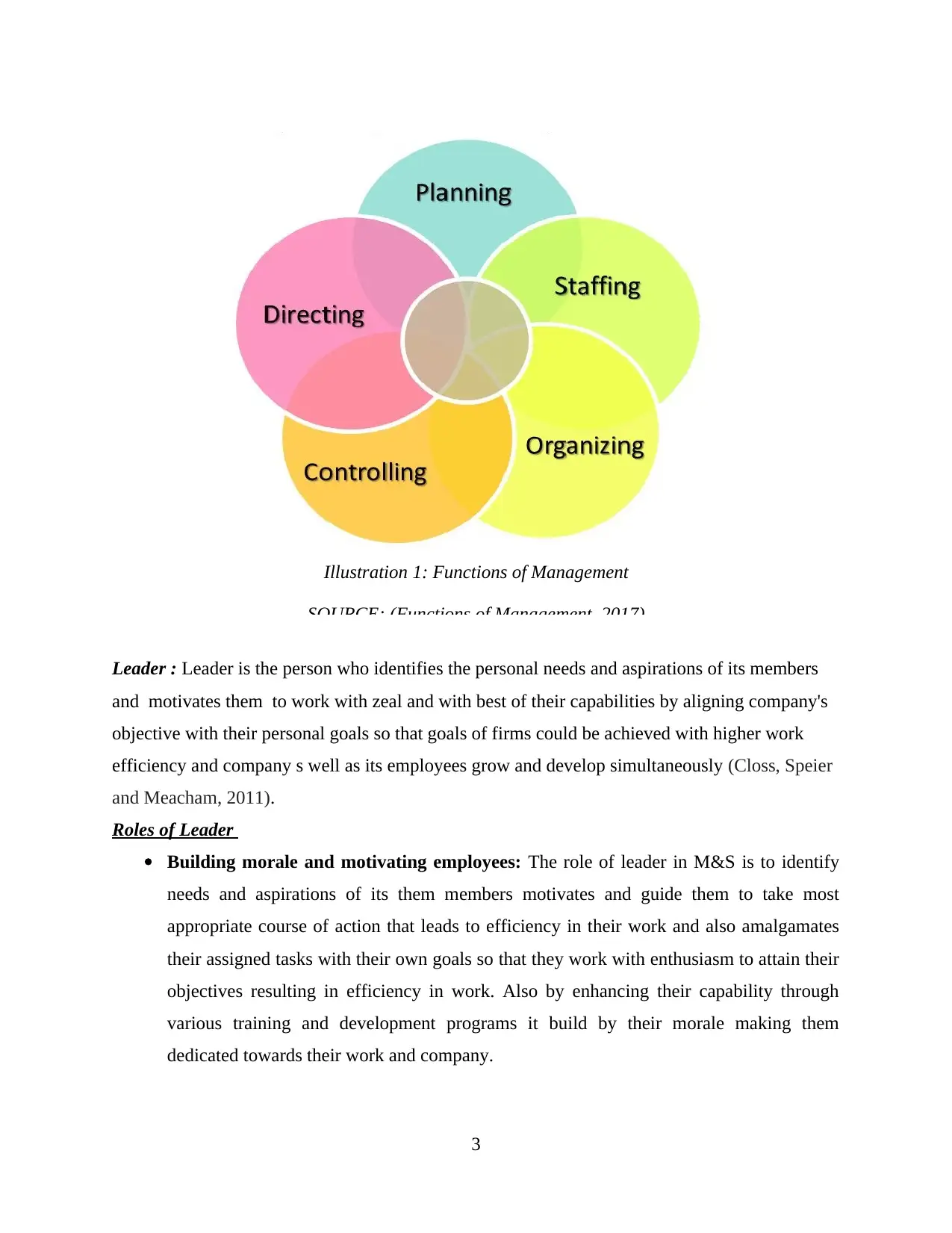
Leader : Leader is the person who identifies the personal needs and aspirations of its members
and motivates them to work with zeal and with best of their capabilities by aligning company's
objective with their personal goals so that goals of firms could be achieved with higher work
efficiency and company s well as its employees grow and develop simultaneously (Closs, Speier
and Meacham, 2011).
Roles of Leader
Building morale and motivating employees: The role of leader in M&S is to identify
needs and aspirations of its them members motivates and guide them to take most
appropriate course of action that leads to efficiency in their work and also amalgamates
their assigned tasks with their own goals so that they work with enthusiasm to attain their
objectives resulting in efficiency in work. Also by enhancing their capability through
various training and development programs it build by their morale making them
dedicated towards their work and company.
3
Illustration 1: Functions of Management
SOURCE: (Functions of Management, 2017)
and motivates them to work with zeal and with best of their capabilities by aligning company's
objective with their personal goals so that goals of firms could be achieved with higher work
efficiency and company s well as its employees grow and develop simultaneously (Closs, Speier
and Meacham, 2011).
Roles of Leader
Building morale and motivating employees: The role of leader in M&S is to identify
needs and aspirations of its them members motivates and guide them to take most
appropriate course of action that leads to efficiency in their work and also amalgamates
their assigned tasks with their own goals so that they work with enthusiasm to attain their
objectives resulting in efficiency in work. Also by enhancing their capability through
various training and development programs it build by their morale making them
dedicated towards their work and company.
3
Illustration 1: Functions of Management
SOURCE: (Functions of Management, 2017)
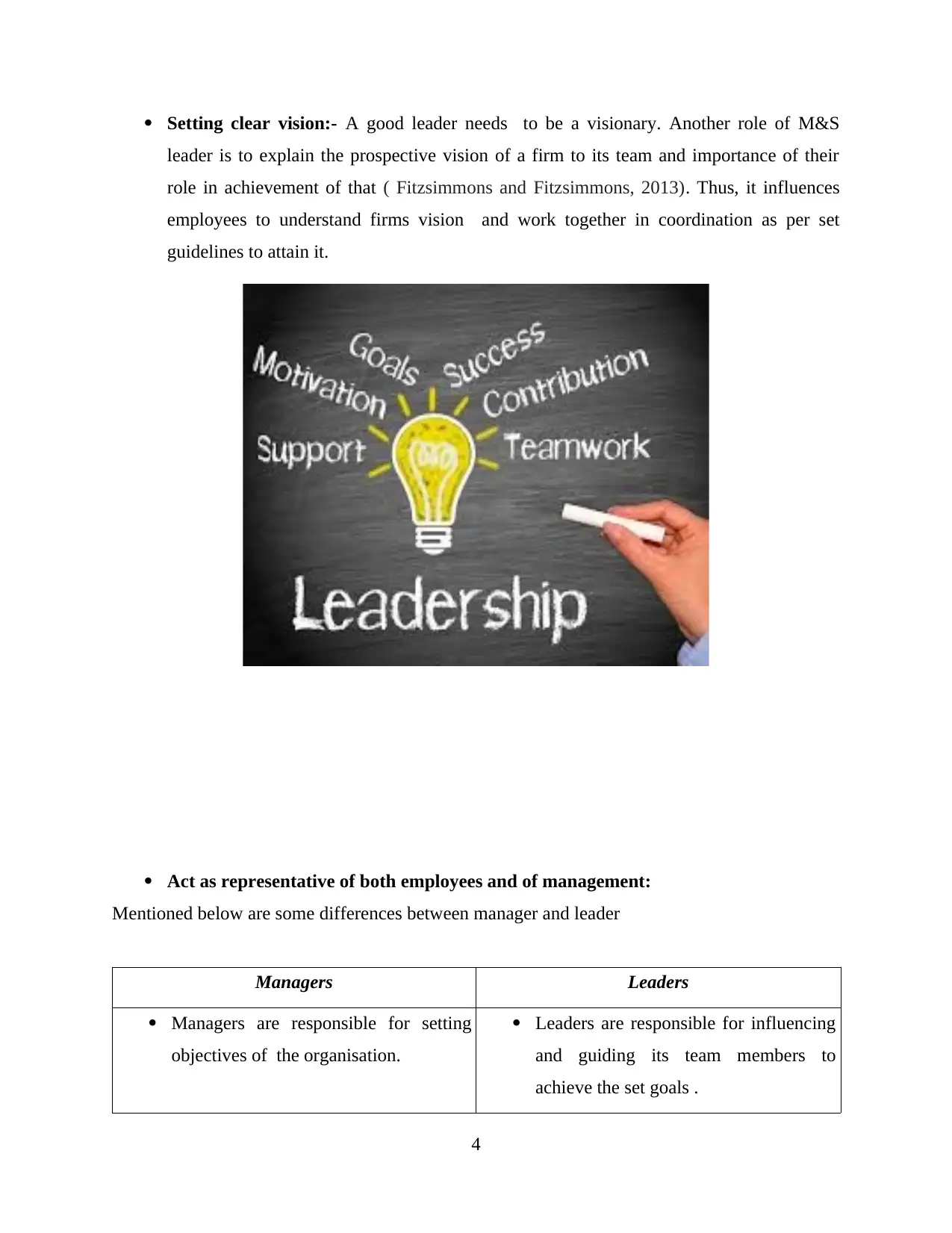
Setting clear vision:- A good leader needs to be a visionary. Another role of M&S
leader is to explain the prospective vision of a firm to its team and importance of their
role in achievement of that ( Fitzsimmons and Fitzsimmons, 2013). Thus, it influences
employees to understand firms vision and work together in coordination as per set
guidelines to attain it.
Act as representative of both employees and of management:
Mentioned below are some differences between manager and leader
Managers Leaders
Managers are responsible for setting
objectives of the organisation.
Leaders are responsible for influencing
and guiding its team members to
achieve the set goals .
4
leader is to explain the prospective vision of a firm to its team and importance of their
role in achievement of that ( Fitzsimmons and Fitzsimmons, 2013). Thus, it influences
employees to understand firms vision and work together in coordination as per set
guidelines to attain it.
Act as representative of both employees and of management:
Mentioned below are some differences between manager and leader
Managers Leaders
Managers are responsible for setting
objectives of the organisation.
Leaders are responsible for influencing
and guiding its team members to
achieve the set goals .
4
Paraphrase This Document
Need a fresh take? Get an instant paraphrase of this document with our AI Paraphraser
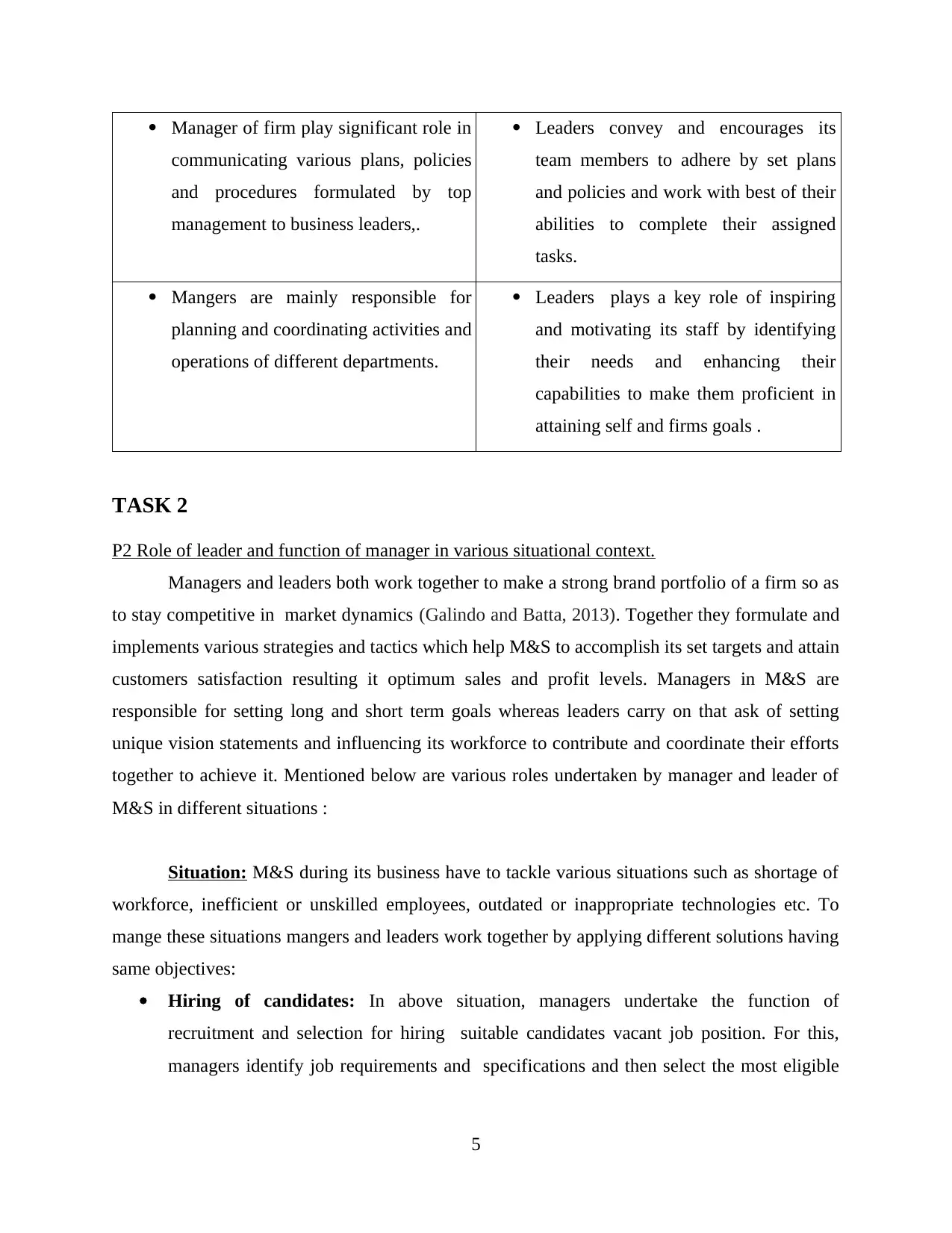
Manager of firm play significant role in
communicating various plans, policies
and procedures formulated by top
management to business leaders,.
Leaders convey and encourages its
team members to adhere by set plans
and policies and work with best of their
abilities to complete their assigned
tasks.
Mangers are mainly responsible for
planning and coordinating activities and
operations of different departments.
Leaders plays a key role of inspiring
and motivating its staff by identifying
their needs and enhancing their
capabilities to make them proficient in
attaining self and firms goals .
TASK 2
P2 Role of leader and function of manager in various situational context.
Managers and leaders both work together to make a strong brand portfolio of a firm so as
to stay competitive in market dynamics (Galindo and Batta, 2013). Together they formulate and
implements various strategies and tactics which help M&S to accomplish its set targets and attain
customers satisfaction resulting it optimum sales and profit levels. Managers in M&S are
responsible for setting long and short term goals whereas leaders carry on that ask of setting
unique vision statements and influencing its workforce to contribute and coordinate their efforts
together to achieve it. Mentioned below are various roles undertaken by manager and leader of
M&S in different situations :
Situation: M&S during its business have to tackle various situations such as shortage of
workforce, inefficient or unskilled employees, outdated or inappropriate technologies etc. To
mange these situations mangers and leaders work together by applying different solutions having
same objectives:
Hiring of candidates: In above situation, managers undertake the function of
recruitment and selection for hiring suitable candidates vacant job position. For this,
managers identify job requirements and specifications and then select the most eligible
5
communicating various plans, policies
and procedures formulated by top
management to business leaders,.
Leaders convey and encourages its
team members to adhere by set plans
and policies and work with best of their
abilities to complete their assigned
tasks.
Mangers are mainly responsible for
planning and coordinating activities and
operations of different departments.
Leaders plays a key role of inspiring
and motivating its staff by identifying
their needs and enhancing their
capabilities to make them proficient in
attaining self and firms goals .
TASK 2
P2 Role of leader and function of manager in various situational context.
Managers and leaders both work together to make a strong brand portfolio of a firm so as
to stay competitive in market dynamics (Galindo and Batta, 2013). Together they formulate and
implements various strategies and tactics which help M&S to accomplish its set targets and attain
customers satisfaction resulting it optimum sales and profit levels. Managers in M&S are
responsible for setting long and short term goals whereas leaders carry on that ask of setting
unique vision statements and influencing its workforce to contribute and coordinate their efforts
together to achieve it. Mentioned below are various roles undertaken by manager and leader of
M&S in different situations :
Situation: M&S during its business have to tackle various situations such as shortage of
workforce, inefficient or unskilled employees, outdated or inappropriate technologies etc. To
mange these situations mangers and leaders work together by applying different solutions having
same objectives:
Hiring of candidates: In above situation, managers undertake the function of
recruitment and selection for hiring suitable candidates vacant job position. For this,
managers identify job requirements and specifications and then select the most eligible
5
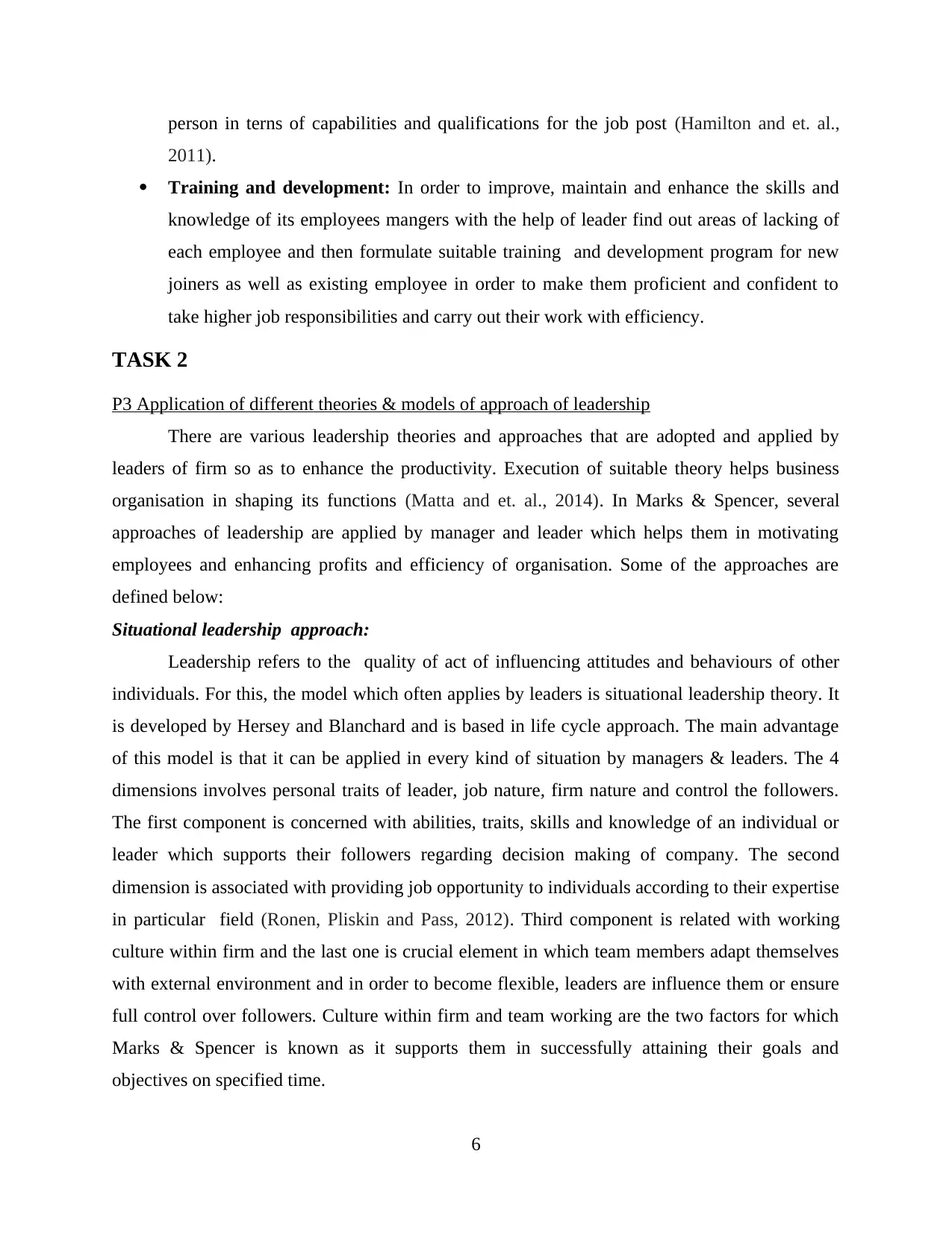
person in terns of capabilities and qualifications for the job post (Hamilton and et. al.,
2011).
Training and development: In order to improve, maintain and enhance the skills and
knowledge of its employees mangers with the help of leader find out areas of lacking of
each employee and then formulate suitable training and development program for new
joiners as well as existing employee in order to make them proficient and confident to
take higher job responsibilities and carry out their work with efficiency.
TASK 2
P3 Application of different theories & models of approach of leadership
There are various leadership theories and approaches that are adopted and applied by
leaders of firm so as to enhance the productivity. Execution of suitable theory helps business
organisation in shaping its functions (Matta and et. al., 2014). In Marks & Spencer, several
approaches of leadership are applied by manager and leader which helps them in motivating
employees and enhancing profits and efficiency of organisation. Some of the approaches are
defined below:
Situational leadership approach:
Leadership refers to the quality of act of influencing attitudes and behaviours of other
individuals. For this, the model which often applies by leaders is situational leadership theory. It
is developed by Hersey and Blanchard and is based in life cycle approach. The main advantage
of this model is that it can be applied in every kind of situation by managers & leaders. The 4
dimensions involves personal traits of leader, job nature, firm nature and control the followers.
The first component is concerned with abilities, traits, skills and knowledge of an individual or
leader which supports their followers regarding decision making of company. The second
dimension is associated with providing job opportunity to individuals according to their expertise
in particular field (Ronen, Pliskin and Pass, 2012). Third component is related with working
culture within firm and the last one is crucial element in which team members adapt themselves
with external environment and in order to become flexible, leaders are influence them or ensure
full control over followers. Culture within firm and team working are the two factors for which
Marks & Spencer is known as it supports them in successfully attaining their goals and
objectives on specified time.
6
2011).
Training and development: In order to improve, maintain and enhance the skills and
knowledge of its employees mangers with the help of leader find out areas of lacking of
each employee and then formulate suitable training and development program for new
joiners as well as existing employee in order to make them proficient and confident to
take higher job responsibilities and carry out their work with efficiency.
TASK 2
P3 Application of different theories & models of approach of leadership
There are various leadership theories and approaches that are adopted and applied by
leaders of firm so as to enhance the productivity. Execution of suitable theory helps business
organisation in shaping its functions (Matta and et. al., 2014). In Marks & Spencer, several
approaches of leadership are applied by manager and leader which helps them in motivating
employees and enhancing profits and efficiency of organisation. Some of the approaches are
defined below:
Situational leadership approach:
Leadership refers to the quality of act of influencing attitudes and behaviours of other
individuals. For this, the model which often applies by leaders is situational leadership theory. It
is developed by Hersey and Blanchard and is based in life cycle approach. The main advantage
of this model is that it can be applied in every kind of situation by managers & leaders. The 4
dimensions involves personal traits of leader, job nature, firm nature and control the followers.
The first component is concerned with abilities, traits, skills and knowledge of an individual or
leader which supports their followers regarding decision making of company. The second
dimension is associated with providing job opportunity to individuals according to their expertise
in particular field (Ronen, Pliskin and Pass, 2012). Third component is related with working
culture within firm and the last one is crucial element in which team members adapt themselves
with external environment and in order to become flexible, leaders are influence them or ensure
full control over followers. Culture within firm and team working are the two factors for which
Marks & Spencer is known as it supports them in successfully attaining their goals and
objectives on specified time.
6
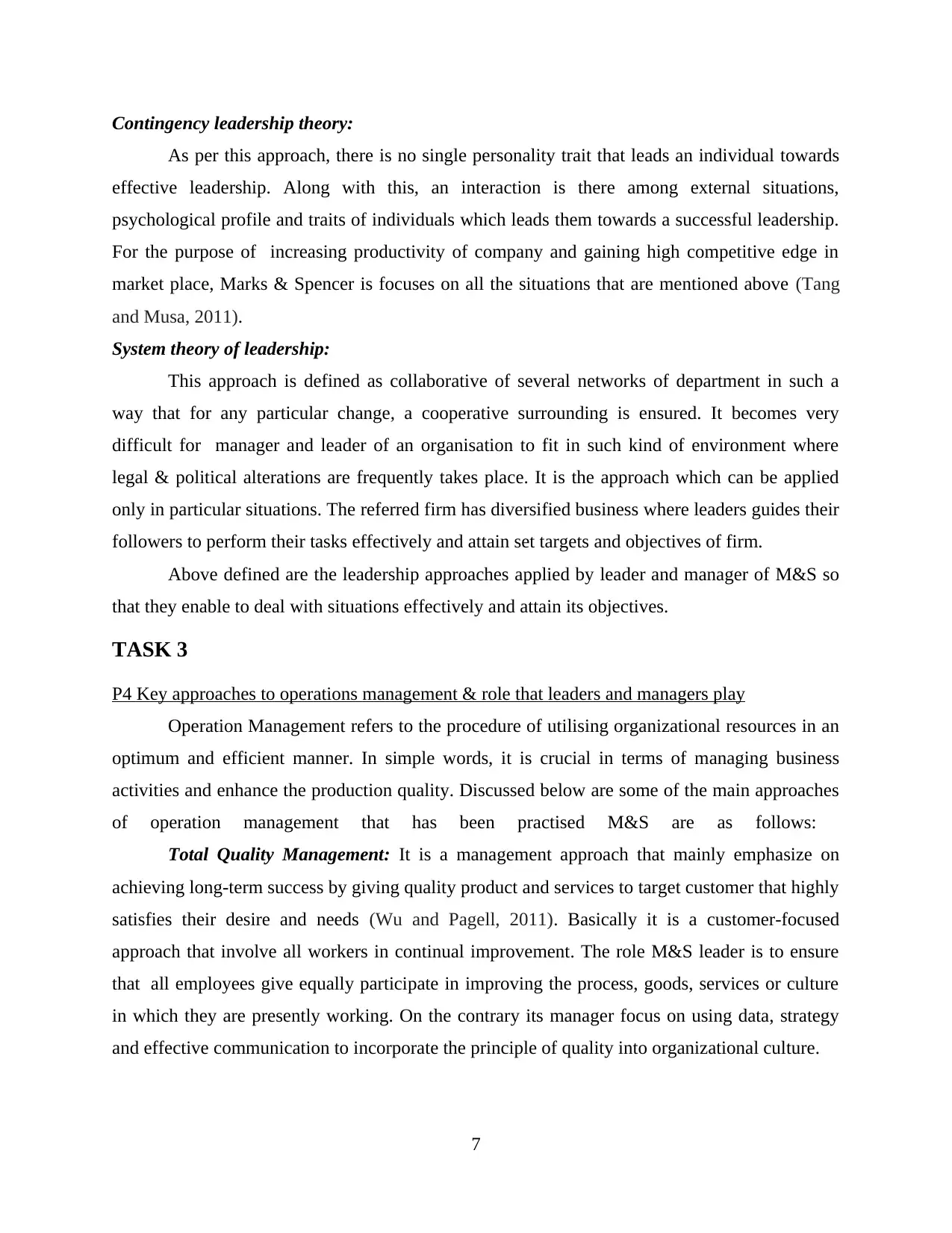
Contingency leadership theory:
As per this approach, there is no single personality trait that leads an individual towards
effective leadership. Along with this, an interaction is there among external situations,
psychological profile and traits of individuals which leads them towards a successful leadership.
For the purpose of increasing productivity of company and gaining high competitive edge in
market place, Marks & Spencer is focuses on all the situations that are mentioned above (Tang
and Musa, 2011).
System theory of leadership:
This approach is defined as collaborative of several networks of department in such a
way that for any particular change, a cooperative surrounding is ensured. It becomes very
difficult for manager and leader of an organisation to fit in such kind of environment where
legal & political alterations are frequently takes place. It is the approach which can be applied
only in particular situations. The referred firm has diversified business where leaders guides their
followers to perform their tasks effectively and attain set targets and objectives of firm.
Above defined are the leadership approaches applied by leader and manager of M&S so
that they enable to deal with situations effectively and attain its objectives.
TASK 3
P4 Key approaches to operations management & role that leaders and managers play
Operation Management refers to the procedure of utilising organizational resources in an
optimum and efficient manner. In simple words, it is crucial in terms of managing business
activities and enhance the production quality. Discussed below are some of the main approaches
of operation management that has been practised M&S are as follows:
Total Quality Management: It is a management approach that mainly emphasize on
achieving long-term success by giving quality product and services to target customer that highly
satisfies their desire and needs (Wu and Pagell, 2011). Basically it is a customer-focused
approach that involve all workers in continual improvement. The role M&S leader is to ensure
that all employees give equally participate in improving the process, goods, services or culture
in which they are presently working. On the contrary its manager focus on using data, strategy
and effective communication to incorporate the principle of quality into organizational culture.
7
As per this approach, there is no single personality trait that leads an individual towards
effective leadership. Along with this, an interaction is there among external situations,
psychological profile and traits of individuals which leads them towards a successful leadership.
For the purpose of increasing productivity of company and gaining high competitive edge in
market place, Marks & Spencer is focuses on all the situations that are mentioned above (Tang
and Musa, 2011).
System theory of leadership:
This approach is defined as collaborative of several networks of department in such a
way that for any particular change, a cooperative surrounding is ensured. It becomes very
difficult for manager and leader of an organisation to fit in such kind of environment where
legal & political alterations are frequently takes place. It is the approach which can be applied
only in particular situations. The referred firm has diversified business where leaders guides their
followers to perform their tasks effectively and attain set targets and objectives of firm.
Above defined are the leadership approaches applied by leader and manager of M&S so
that they enable to deal with situations effectively and attain its objectives.
TASK 3
P4 Key approaches to operations management & role that leaders and managers play
Operation Management refers to the procedure of utilising organizational resources in an
optimum and efficient manner. In simple words, it is crucial in terms of managing business
activities and enhance the production quality. Discussed below are some of the main approaches
of operation management that has been practised M&S are as follows:
Total Quality Management: It is a management approach that mainly emphasize on
achieving long-term success by giving quality product and services to target customer that highly
satisfies their desire and needs (Wu and Pagell, 2011). Basically it is a customer-focused
approach that involve all workers in continual improvement. The role M&S leader is to ensure
that all employees give equally participate in improving the process, goods, services or culture
in which they are presently working. On the contrary its manager focus on using data, strategy
and effective communication to incorporate the principle of quality into organizational culture.
7
Secure Best Marks with AI Grader
Need help grading? Try our AI Grader for instant feedback on your assignments.

Continuous Improvement Process: It refers to the ongoing efforts made by company for
enhancing its product, process or services. These efforts either seek “breakthrough”
improvement at one shot only or “incremental” improvement over the period of time. With the
application of this approach, company can attain high competitive edge in the market over its
rivals. This method is also known as KAIZEN approach. In this approach, leaders play important
role such as M&S leader's not only portray support for taking initiative but also demonstrate the
behaviour that they want their followers to emulate (Yang, Hong and Modi, 2011).
Six Sigma: It is a quality control program mainly designed with an aim of eliminating
defect if any in product, process or services. Here defect is related with manufacturing defect and
this approach focus on reducing this to a level of no more than 3.4 per million. In order words, it
generally laid stress on effectively meeting consumer requirements, sustaining company's
product or services for longer run and improving customer retention. Managers of M&S needs to
ensure that their business process must produce less than 3.4 million defect per 1 million chance
so as to be referred as effective and efficient in terms of delivering goods and services and
satisfying customer requirement.
Lean Manufacturing: It is a systematic method that is mainly taken into consideration
with a purpose of controlling waste within the production department without compromising
productivity. In general, waste is created either overburden or due to unevenness in work load. In
simple words, it a sort of never ending efforts made by company to reduce an activity or waste
that consumer organizational resources without adding value in the final goods or services. The
role of M&S leader is to identify such activities that causing wastage and take corrective actions
accordingly. On the other hand manager of M&S needs to check whether company's resources
are optimally utilized or not.
P5 Importance & value of operations management in attaining business objectives
Concept of operations management plays vital role in long term success and growth of
company. It is the function that is associated with cost control and enhancing efficiency of
production process (Ashby, Leat and Hudson-Smith, 2011). It is the area which highly
contributes in success and growth of company. Application of operations management in
activities of company helps in reducing cost of manufacturing as well as ensures optimum
utilization of available resources. In Marks & Spencer, it helps in producing high quality
8
enhancing its product, process or services. These efforts either seek “breakthrough”
improvement at one shot only or “incremental” improvement over the period of time. With the
application of this approach, company can attain high competitive edge in the market over its
rivals. This method is also known as KAIZEN approach. In this approach, leaders play important
role such as M&S leader's not only portray support for taking initiative but also demonstrate the
behaviour that they want their followers to emulate (Yang, Hong and Modi, 2011).
Six Sigma: It is a quality control program mainly designed with an aim of eliminating
defect if any in product, process or services. Here defect is related with manufacturing defect and
this approach focus on reducing this to a level of no more than 3.4 per million. In order words, it
generally laid stress on effectively meeting consumer requirements, sustaining company's
product or services for longer run and improving customer retention. Managers of M&S needs to
ensure that their business process must produce less than 3.4 million defect per 1 million chance
so as to be referred as effective and efficient in terms of delivering goods and services and
satisfying customer requirement.
Lean Manufacturing: It is a systematic method that is mainly taken into consideration
with a purpose of controlling waste within the production department without compromising
productivity. In general, waste is created either overburden or due to unevenness in work load. In
simple words, it a sort of never ending efforts made by company to reduce an activity or waste
that consumer organizational resources without adding value in the final goods or services. The
role of M&S leader is to identify such activities that causing wastage and take corrective actions
accordingly. On the other hand manager of M&S needs to check whether company's resources
are optimally utilized or not.
P5 Importance & value of operations management in attaining business objectives
Concept of operations management plays vital role in long term success and growth of
company. It is the function that is associated with cost control and enhancing efficiency of
production process (Ashby, Leat and Hudson-Smith, 2011). It is the area which highly
contributes in success and growth of company. Application of operations management in
activities of company helps in reducing cost of manufacturing as well as ensures optimum
utilization of available resources. In Marks & Spencer, it helps in producing high quality
8
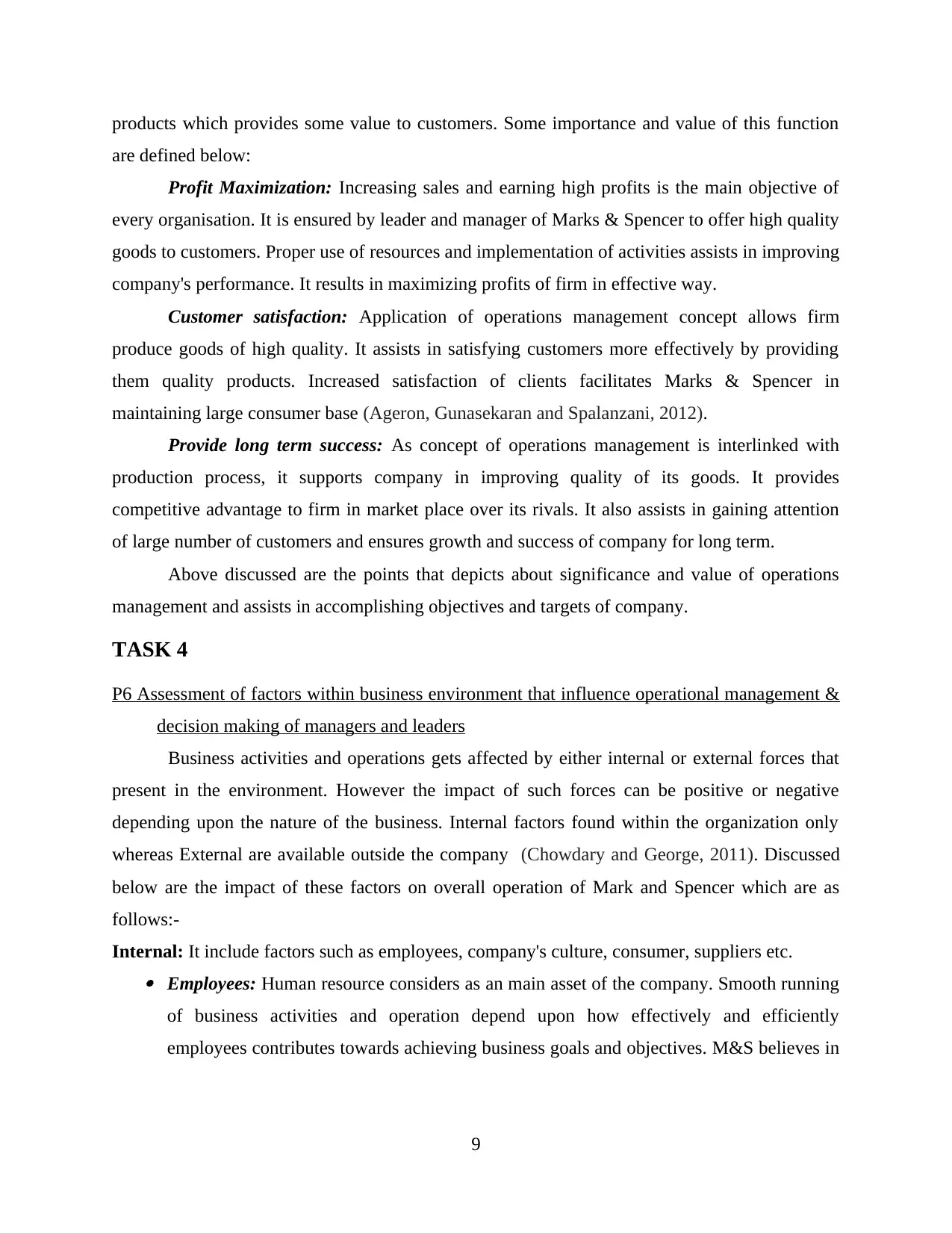
products which provides some value to customers. Some importance and value of this function
are defined below:
Profit Maximization: Increasing sales and earning high profits is the main objective of
every organisation. It is ensured by leader and manager of Marks & Spencer to offer high quality
goods to customers. Proper use of resources and implementation of activities assists in improving
company's performance. It results in maximizing profits of firm in effective way.
Customer satisfaction: Application of operations management concept allows firm
produce goods of high quality. It assists in satisfying customers more effectively by providing
them quality products. Increased satisfaction of clients facilitates Marks & Spencer in
maintaining large consumer base (Ageron, Gunasekaran and Spalanzani, 2012).
Provide long term success: As concept of operations management is interlinked with
production process, it supports company in improving quality of its goods. It provides
competitive advantage to firm in market place over its rivals. It also assists in gaining attention
of large number of customers and ensures growth and success of company for long term.
Above discussed are the points that depicts about significance and value of operations
management and assists in accomplishing objectives and targets of company.
TASK 4
P6 Assessment of factors within business environment that influence operational management &
decision making of managers and leaders
Business activities and operations gets affected by either internal or external forces that
present in the environment. However the impact of such forces can be positive or negative
depending upon the nature of the business. Internal factors found within the organization only
whereas External are available outside the company (Chowdary and George, 2011). Discussed
below are the impact of these factors on overall operation of Mark and Spencer which are as
follows:-
Internal: It include factors such as employees, company's culture, consumer, suppliers etc. Employees: Human resource considers as an main asset of the company. Smooth running
of business activities and operation depend upon how effectively and efficiently
employees contributes towards achieving business goals and objectives. M&S believes in
9
are defined below:
Profit Maximization: Increasing sales and earning high profits is the main objective of
every organisation. It is ensured by leader and manager of Marks & Spencer to offer high quality
goods to customers. Proper use of resources and implementation of activities assists in improving
company's performance. It results in maximizing profits of firm in effective way.
Customer satisfaction: Application of operations management concept allows firm
produce goods of high quality. It assists in satisfying customers more effectively by providing
them quality products. Increased satisfaction of clients facilitates Marks & Spencer in
maintaining large consumer base (Ageron, Gunasekaran and Spalanzani, 2012).
Provide long term success: As concept of operations management is interlinked with
production process, it supports company in improving quality of its goods. It provides
competitive advantage to firm in market place over its rivals. It also assists in gaining attention
of large number of customers and ensures growth and success of company for long term.
Above discussed are the points that depicts about significance and value of operations
management and assists in accomplishing objectives and targets of company.
TASK 4
P6 Assessment of factors within business environment that influence operational management &
decision making of managers and leaders
Business activities and operations gets affected by either internal or external forces that
present in the environment. However the impact of such forces can be positive or negative
depending upon the nature of the business. Internal factors found within the organization only
whereas External are available outside the company (Chowdary and George, 2011). Discussed
below are the impact of these factors on overall operation of Mark and Spencer which are as
follows:-
Internal: It include factors such as employees, company's culture, consumer, suppliers etc. Employees: Human resource considers as an main asset of the company. Smooth running
of business activities and operation depend upon how effectively and efficiently
employees contributes towards achieving business goals and objectives. M&S believes in
9

hiring skilled and competent personnel who with their adequate knowledge, ability and
skills help in attaining high competitive edge in the market.
Company's Culture: Internal culture of any firm compromise of attitudes, values,
behaviour and priorities of its employees. Culture posses a huge impact on the
performance and productivity of an individual. For example: If there is a culture of cut-
throat competition prevailing in the business, then every employee tries to compete with
one another and this promote different environment from the one where all personnel
prefer to work in a team or group. The culture of M&S is healthy and positive that play
key role in motivating and inspiring their employees to work incredibly hard. In addition
to that, M&S arrange adequate training session that help in growth and development of
their workers both personally and professionally (Wilson, 2015).
External: It compromise of factors such as political, social, technological etc.
Political: It include all rules and regulation formulated by Government that every
business enterprise is bound to follow. Recently, UK government has formulate standards
related with Health and Safety British Standards that all UK-based firms are obliged to
taken into account. However, M&S did not abide on the rules and regulation granted by
government body. As a result, it has to deal with negative consequence for the same
which tarnish their brand image.
Technological: Taking the advantage of latest and advance technology, M&S is gaining
high competitive edge over its rivals by introducing its own mobile application and
website. As a result, its market and customer base increases.
CONCLUSION
The project undertaken concludes that leaders and mangers have a blurring line in their
roles and responsibilities that they undertake in an organization. Both have to perform certain
roles and functions that requires high efficiency and capabilities. Marks and Spencer have
proficient managers and leaders who keep on updating its staff by providing them useful
information related to changing market dynamics. Moreover leaders execute different leadership
styles in accordance to needs and types of its workforce to motivate its team and maintain
discipline and smooth work flow within firm.
10
skills help in attaining high competitive edge in the market.
Company's Culture: Internal culture of any firm compromise of attitudes, values,
behaviour and priorities of its employees. Culture posses a huge impact on the
performance and productivity of an individual. For example: If there is a culture of cut-
throat competition prevailing in the business, then every employee tries to compete with
one another and this promote different environment from the one where all personnel
prefer to work in a team or group. The culture of M&S is healthy and positive that play
key role in motivating and inspiring their employees to work incredibly hard. In addition
to that, M&S arrange adequate training session that help in growth and development of
their workers both personally and professionally (Wilson, 2015).
External: It compromise of factors such as political, social, technological etc.
Political: It include all rules and regulation formulated by Government that every
business enterprise is bound to follow. Recently, UK government has formulate standards
related with Health and Safety British Standards that all UK-based firms are obliged to
taken into account. However, M&S did not abide on the rules and regulation granted by
government body. As a result, it has to deal with negative consequence for the same
which tarnish their brand image.
Technological: Taking the advantage of latest and advance technology, M&S is gaining
high competitive edge over its rivals by introducing its own mobile application and
website. As a result, its market and customer base increases.
CONCLUSION
The project undertaken concludes that leaders and mangers have a blurring line in their
roles and responsibilities that they undertake in an organization. Both have to perform certain
roles and functions that requires high efficiency and capabilities. Marks and Spencer have
proficient managers and leaders who keep on updating its staff by providing them useful
information related to changing market dynamics. Moreover leaders execute different leadership
styles in accordance to needs and types of its workforce to motivate its team and maintain
discipline and smooth work flow within firm.
10
Paraphrase This Document
Need a fresh take? Get an instant paraphrase of this document with our AI Paraphraser

11
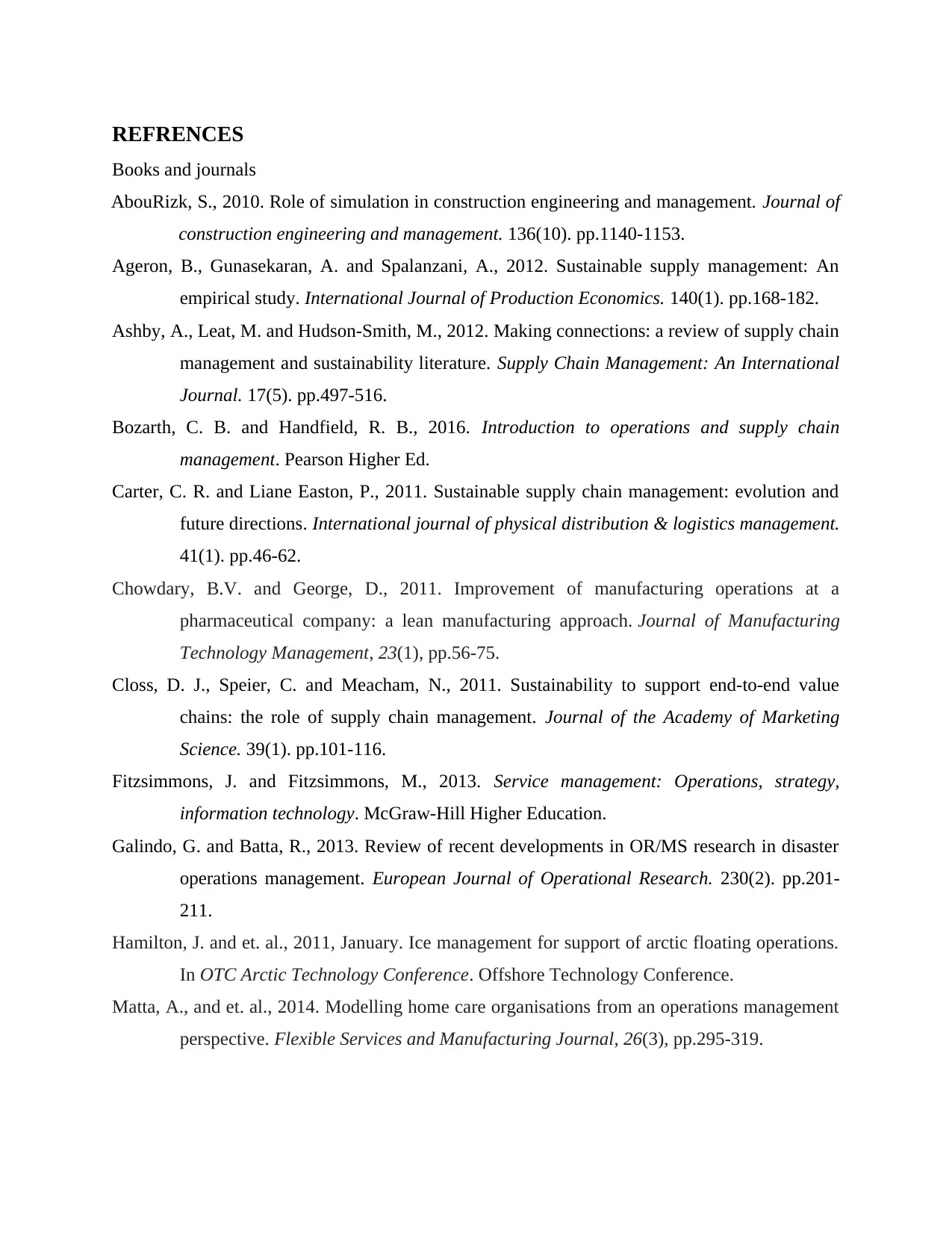
REFRENCES
Books and journals
AbouRizk, S., 2010. Role of simulation in construction engineering and management. Journal of
construction engineering and management. 136(10). pp.1140-1153.
Ageron, B., Gunasekaran, A. and Spalanzani, A., 2012. Sustainable supply management: An
empirical study. International Journal of Production Economics. 140(1). pp.168-182.
Ashby, A., Leat, M. and Hudson-Smith, M., 2012. Making connections: a review of supply chain
management and sustainability literature. Supply Chain Management: An International
Journal. 17(5). pp.497-516.
Bozarth, C. B. and Handfield, R. B., 2016. Introduction to operations and supply chain
management. Pearson Higher Ed.
Carter, C. R. and Liane Easton, P., 2011. Sustainable supply chain management: evolution and
future directions. International journal of physical distribution & logistics management.
41(1). pp.46-62.
Chowdary, B.V. and George, D., 2011. Improvement of manufacturing operations at a
pharmaceutical company: a lean manufacturing approach. Journal of Manufacturing
Technology Management, 23(1), pp.56-75.
Closs, D. J., Speier, C. and Meacham, N., 2011. Sustainability to support end-to-end value
chains: the role of supply chain management. Journal of the Academy of Marketing
Science. 39(1). pp.101-116.
Fitzsimmons, J. and Fitzsimmons, M., 2013. Service management: Operations, strategy,
information technology. McGraw-Hill Higher Education.
Galindo, G. and Batta, R., 2013. Review of recent developments in OR/MS research in disaster
operations management. European Journal of Operational Research. 230(2). pp.201-
211.
Hamilton, J. and et. al., 2011, January. Ice management for support of arctic floating operations.
In OTC Arctic Technology Conference. Offshore Technology Conference.
Matta, A., and et. al., 2014. Modelling home care organisations from an operations management
perspective. Flexible Services and Manufacturing Journal, 26(3), pp.295-319.
Books and journals
AbouRizk, S., 2010. Role of simulation in construction engineering and management. Journal of
construction engineering and management. 136(10). pp.1140-1153.
Ageron, B., Gunasekaran, A. and Spalanzani, A., 2012. Sustainable supply management: An
empirical study. International Journal of Production Economics. 140(1). pp.168-182.
Ashby, A., Leat, M. and Hudson-Smith, M., 2012. Making connections: a review of supply chain
management and sustainability literature. Supply Chain Management: An International
Journal. 17(5). pp.497-516.
Bozarth, C. B. and Handfield, R. B., 2016. Introduction to operations and supply chain
management. Pearson Higher Ed.
Carter, C. R. and Liane Easton, P., 2011. Sustainable supply chain management: evolution and
future directions. International journal of physical distribution & logistics management.
41(1). pp.46-62.
Chowdary, B.V. and George, D., 2011. Improvement of manufacturing operations at a
pharmaceutical company: a lean manufacturing approach. Journal of Manufacturing
Technology Management, 23(1), pp.56-75.
Closs, D. J., Speier, C. and Meacham, N., 2011. Sustainability to support end-to-end value
chains: the role of supply chain management. Journal of the Academy of Marketing
Science. 39(1). pp.101-116.
Fitzsimmons, J. and Fitzsimmons, M., 2013. Service management: Operations, strategy,
information technology. McGraw-Hill Higher Education.
Galindo, G. and Batta, R., 2013. Review of recent developments in OR/MS research in disaster
operations management. European Journal of Operational Research. 230(2). pp.201-
211.
Hamilton, J. and et. al., 2011, January. Ice management for support of arctic floating operations.
In OTC Arctic Technology Conference. Offshore Technology Conference.
Matta, A., and et. al., 2014. Modelling home care organisations from an operations management
perspective. Flexible Services and Manufacturing Journal, 26(3), pp.295-319.
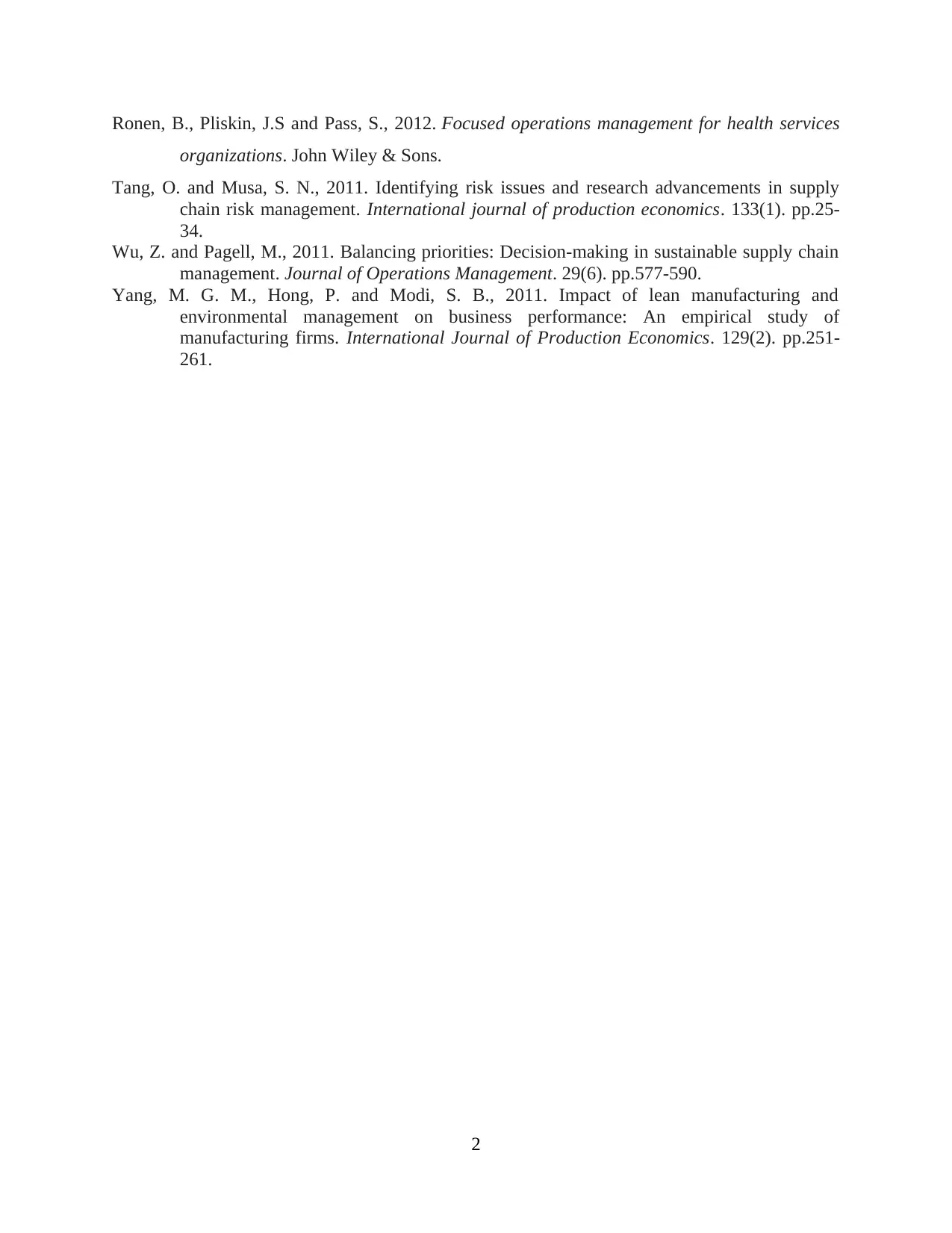
Ronen, B., Pliskin, J.S and Pass, S., 2012. Focused operations management for health services
organizations. John Wiley & Sons.
Tang, O. and Musa, S. N., 2011. Identifying risk issues and research advancements in supply
chain risk management. International journal of production economics. 133(1). pp.25-
34.
Wu, Z. and Pagell, M., 2011. Balancing priorities: Decision-making in sustainable supply chain
management. Journal of Operations Management. 29(6). pp.577-590.
Yang, M. G. M., Hong, P. and Modi, S. B., 2011. Impact of lean manufacturing and
environmental management on business performance: An empirical study of
manufacturing firms. International Journal of Production Economics. 129(2). pp.251-
261.
2
organizations. John Wiley & Sons.
Tang, O. and Musa, S. N., 2011. Identifying risk issues and research advancements in supply
chain risk management. International journal of production economics. 133(1). pp.25-
34.
Wu, Z. and Pagell, M., 2011. Balancing priorities: Decision-making in sustainable supply chain
management. Journal of Operations Management. 29(6). pp.577-590.
Yang, M. G. M., Hong, P. and Modi, S. B., 2011. Impact of lean manufacturing and
environmental management on business performance: An empirical study of
manufacturing firms. International Journal of Production Economics. 129(2). pp.251-
261.
2
1 out of 16
Your All-in-One AI-Powered Toolkit for Academic Success.
+13062052269
info@desklib.com
Available 24*7 on WhatsApp / Email
![[object Object]](/_next/static/media/star-bottom.7253800d.svg)
Unlock your academic potential
© 2024 | Zucol Services PVT LTD | All rights reserved.




